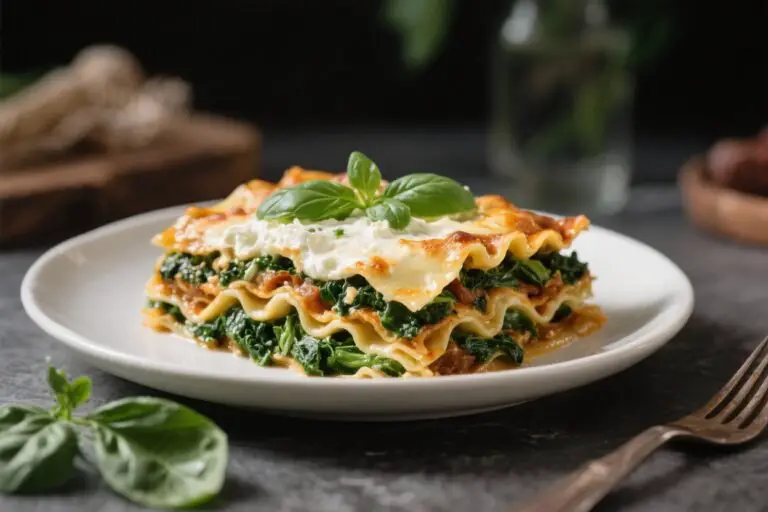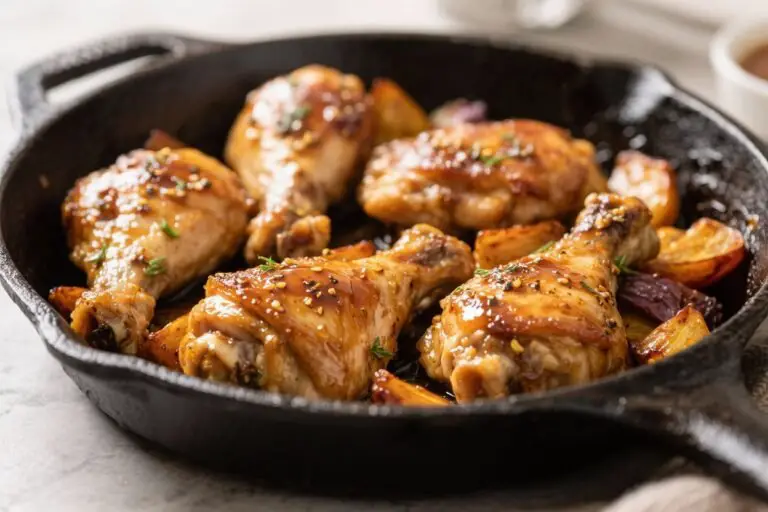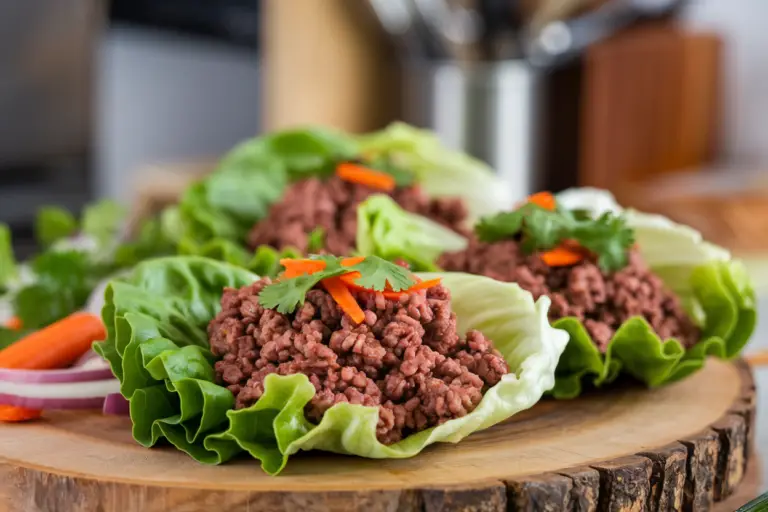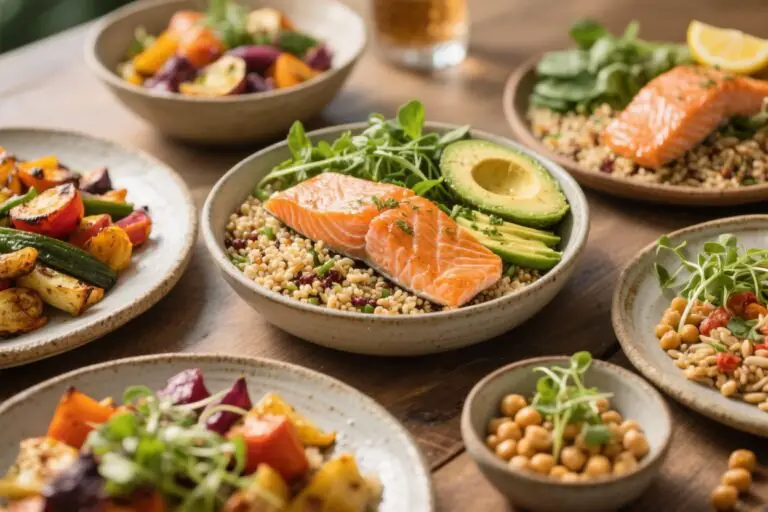Seared Tuna with Lemon Garlic Asparagus: The 10-Minute Power Dinner That Looks Fancy and Hits Hard
You don’t need a chef’s coat to cook like a boss—just a hot pan, good tuna, and a lemon that still has a job. This isn’t a “meal”; it’s a flex. Crispy, peppery sear on the outside, ruby in the middle, with asparagus that snaps like it’s auditioning for a commercial.
Fast, clean, high-protein, and way better than another sad desk salad. If you’re hungry, busy, and slightly picky (same), this is your new go-to.
What Makes This Recipe Awesome

- Ridiculously fast: From cutting board to plate in under 15 minutes. Yes, even on a Tuesday.
- Restaurant vibes, home effort: The tuna gets that dramatic sear-and-slice moment, without any culinary school trauma.
- Lean and clean: High-protein tuna, fiber-rich asparagus, bright lemon, and real garlic.
That’s it—no weird sauces pretending to be healthy.
- Flexible flavors: Citrus, heat, sesame, herbs—this dish takes what you throw at it.
- Minimal cleanup: One skillet, a cutting board, and you’re done. Your sink will forgive you.
Ingredients
- For the tuna:
- 2 ahi tuna steaks (about 6–8 oz each, 1–1.5 inches thick), sushi-grade if possible
- 1 tablespoon neutral high-heat oil (avocado, grapeseed, or refined olive oil)
- 1 teaspoon toasted sesame oil (optional but excellent)
- 1 teaspoon coarse sea salt
- 1 teaspoon freshly ground black pepper
- 1 teaspoon sesame seeds (white or black), optional
- 1/2 teaspoon crushed red pepper flakes (optional, for heat)
- For the lemon garlic asparagus:
- 1 large bunch asparagus (about 1 lb), tough ends trimmed
- 1 tablespoon olive oil
- 2–3 garlic cloves, thinly sliced
- Zest of 1 lemon
- Juice of 1/2–1 lemon (to taste)
- 1/2 teaspoon kosher salt
- Freshly ground black pepper, to taste
- To finish:
- Lemon wedges
- Fresh parsley or chives, chopped (optional)
- Flaky sea salt, for serving
Cooking Instructions
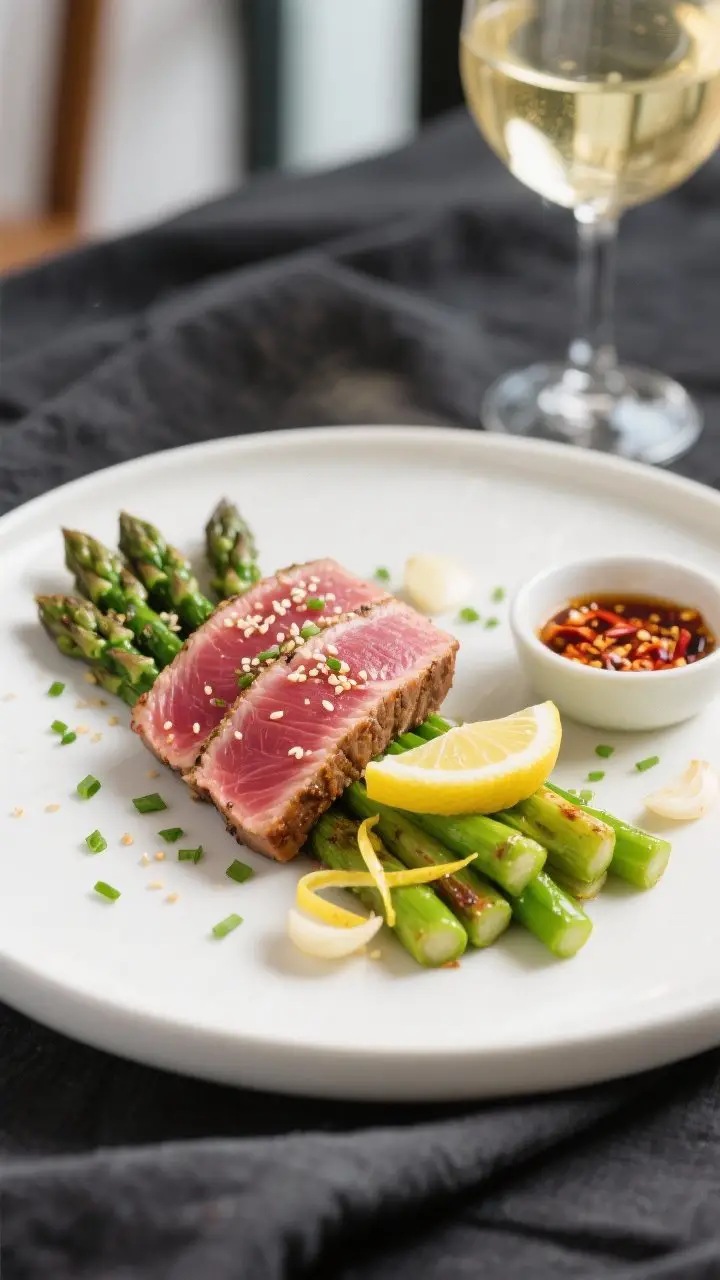
- Pat the tuna dry like you mean it. Moisture is the enemy of a great sear. Use paper towels and blot both sides thoroughly.
- Season with intention. Rub tuna with the neutral oil and sesame oil.
Sprinkle on salt, black pepper, sesame seeds, and red pepper flakes (if using). Press lightly to adhere.
- Preheat the skillet. Use a heavy stainless or cast-iron pan. Heat over medium-high until it’s very hot—like “a drop of water sizzles instantly” hot.
- Prep the asparagus. Snap or trim the woody ends.
Toss spears with olive oil, garlic, lemon zest, salt, and pepper.
- Sear the asparagus first. Add asparagus to the hot pan. Cook 3–5 minutes, turning occasionally, until bright green with light char. Add lemon juice in the last 30 seconds.
Transfer to a warm plate.
- Crank the heat slightly and sear the tuna. Add a touch more neutral oil if the pan looks dry. Lay tuna steaks in the pan and press gently for 2–3 seconds for even contact.
- Timing is everything. For rare: 45–60 seconds per side. For medium-rare: 75–90 seconds per side.
Don’t overcook—you’re aiming for a ruby center.
- Rest briefly. Remove tuna to a board and let sit 1 minute. This lets the juices chill out and makes slicing cleaner.
- Slice like a pro. Cut tuna against the grain into 1/4–1/2-inch slices. Sprinkle with flaky sea salt and a squeeze of lemon.
- Plate and finish. Pile asparagus on plates, top with tuna slices, shower with herbs, and add extra lemon wedges.
Snap a pic, because obviously.
Storage Tips
- Short-term: Store tuna and asparagus separately in airtight containers. Tuna is best within 24 hours for quality.
- Serving later: Eat tuna cold or room temp rather than reheating to avoid overcooking. Asparagus can be quickly warmed in a skillet with a splash of water.
- Meal prep move: Keep lemon wedges separate so flavors stay bright when serving.
- Freezing? Not recommended for seared tuna; texture suffers.
Asparagus also gets mushy. Hard pass.
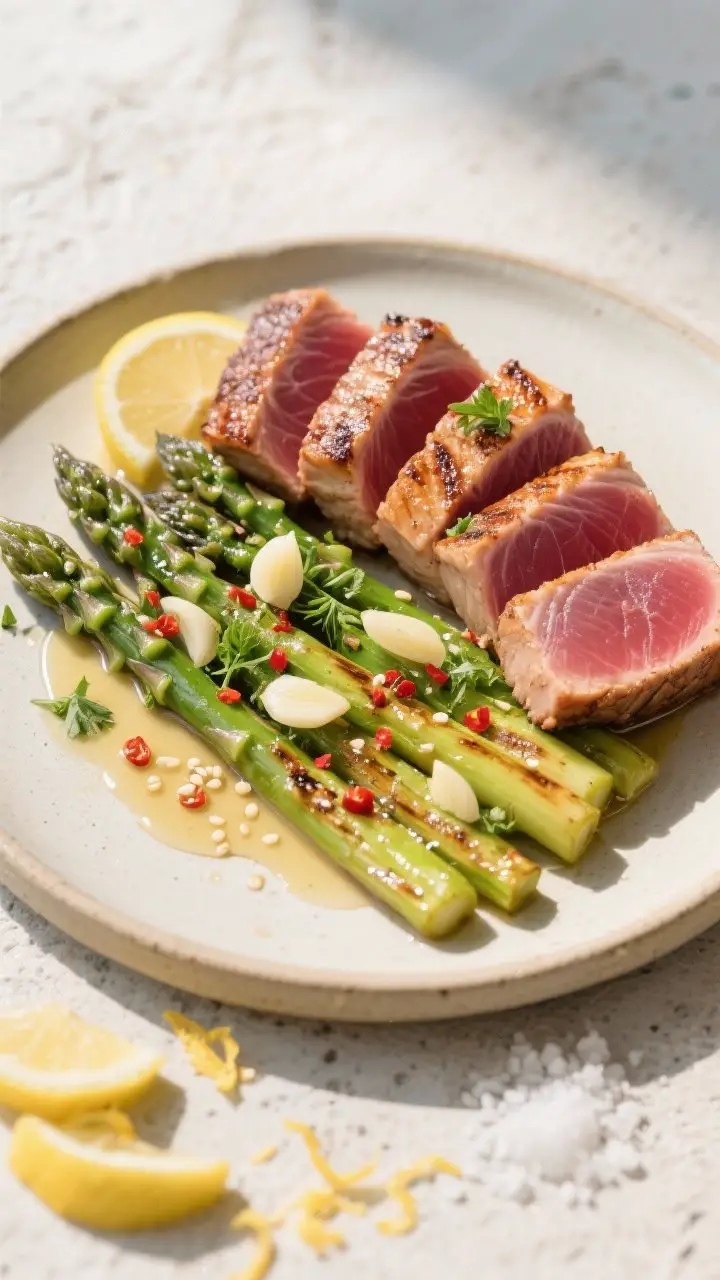
Benefits of This Recipe
- High protein, low nonsense: Tuna delivers lean protein that actually keeps you full.
- Omega-3s on deck: Supports brain and heart health. Your future self says thanks.
- Micronutrient boost: Asparagus brings fiber, folate, and vitamins A, C, and K.
Lemon and garlic add antioxidants and flavor without extra calories.
- Fast recovery meal: Post-workout friendly: protein + micronutrients without heavy carbs. Add rice or potatoes if you want more fuel.
- Gluten-free and dairy-free: Naturally fits a lot of diets without trying too hard, FYI.
Don’t Make These Errors
- Skipping the dry-off step: Wet tuna = steamed tuna. You want a crust, not regret.
- Overcooking the fish: Tuna goes tough fast.
Set a timer and trust it.
- Underheating the pan: If the pan isn’t hot, the crust won’t form and the fish will stick. Preheat like you mean it.
- Using old asparagus: Limp spears taste like sadness. Fresh, firm, snappy stalks only.
- Drowning it in lemon too early: Acid can dull the sear.
Finish with lemon; don’t soak the tuna while cooking.
Mix It Up
- Spice road: Rub tuna with a mix of black pepper, Aleppo pepper, and coriander. Finish with a drizzle of chili crisp.
- Sesame-crusted: Press tuna into a 50/50 mix of white and black sesame seeds. Sear as directed for mega-crunch.
- Mediterranean mood: Add chopped olives, capers, and parsley.
Swap sesame oil for extra virgin olive oil.
- Citrus swap: Use lime and orange zest for a brighter, slightly sweeter vibe. Great with cilantro.
- Carb companion: Serve with garlic rice, roasted baby potatoes, or quinoa if you want extra fuel (IMO quinoa + lemon = yes).
- Sauce it up: Whisk 1 tablespoon soy or tamari, 1 teaspoon honey, 1 teaspoon rice vinegar, and 1 teaspoon sesame oil. Drizzle lightly over the tuna.
FAQ
How do I know when the tuna is perfectly cooked?
Aim for a deep golden crust on the outside and a cool to slightly warm ruby center.
📖 Get Access to 50+ Printable Smoothie Recipes Instantly! 🖨️
Boost your health with delicious smoothies! These easy-to-follow printable recipe eBooks are perfect for detoxing, fitness goals, and tasty plant-based living. Available for instant download on Etsy! 🌿✨
For rare, 45–60 seconds per side; for medium-rare, 75–90 seconds per side. If it’s turning gray all the way through, you’ve gone too far.
Can I use frozen tuna steaks?
Yes, just thaw in the fridge overnight and pat very dry. Quality matters—look for center-cut, sushi-grade if possible for the best texture and flavor.
What if I don’t have a cast-iron skillet?
A heavy stainless steel pan works well.
Nonstick can do in a pinch, but you’ll get a weaker crust and should avoid super-high heat.
Is there a good substitute for asparagus?
Absolutely. Try broccolini, green beans, or zucchini spears. Keep the lemon and garlic—they’re doing heavy lifting.
How do I make it more well done without drying it out?
Sear normally, then finish with a quick 1–2 minute covered rest off heat.
It will gently carry over-cook. Still, tuna shines best at rare to medium-rare.
What wine pairs well with this?
Crisp whites like Sauvignon Blanc or Albariño are excellent. A dry rosé also slaps with the lemon-garlic profile.
Is mercury a concern with tuna?
Moderation is wise.
Enjoy this meal but rotate in lower-mercury fish like salmon, trout, or sardines on other days, especially for pregnant individuals.
Can I grill the tuna instead?
Yes—preheat a clean, oiled grill to high. Sear 45–60 seconds per side for rare, just like the skillet method.
What if I hate garlic?
Skip it and use shallots or a pinch of garlic powder for a toned-down version. The lemon and pepper still carry the dish.
How do I keep the tuna from sticking?
Heat the pan properly, oil the fish lightly, and don’t move it for the first 30 seconds.
If it resists flipping, give it 10 more seconds—it will release when the crust forms.
Wrapping Up
Seared Tuna with Lemon Garlic Asparagus is the rare combo: fast, impressive, and actually good for you. You get crispy-seared edges, buttery tender fish, and bright, garlicky greens in minutes. Keep the ingredients simple, the pan hot, and the lemon ready.
Boom—weeknight hero status unlocked.


